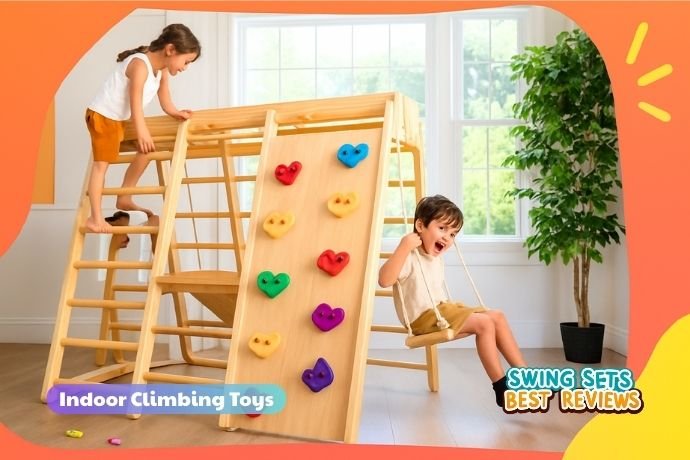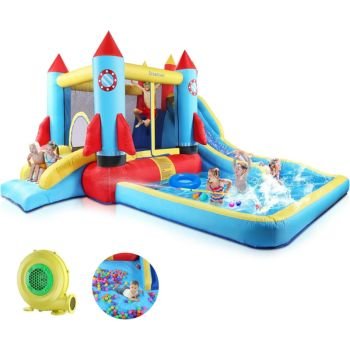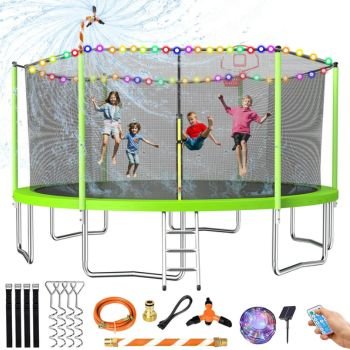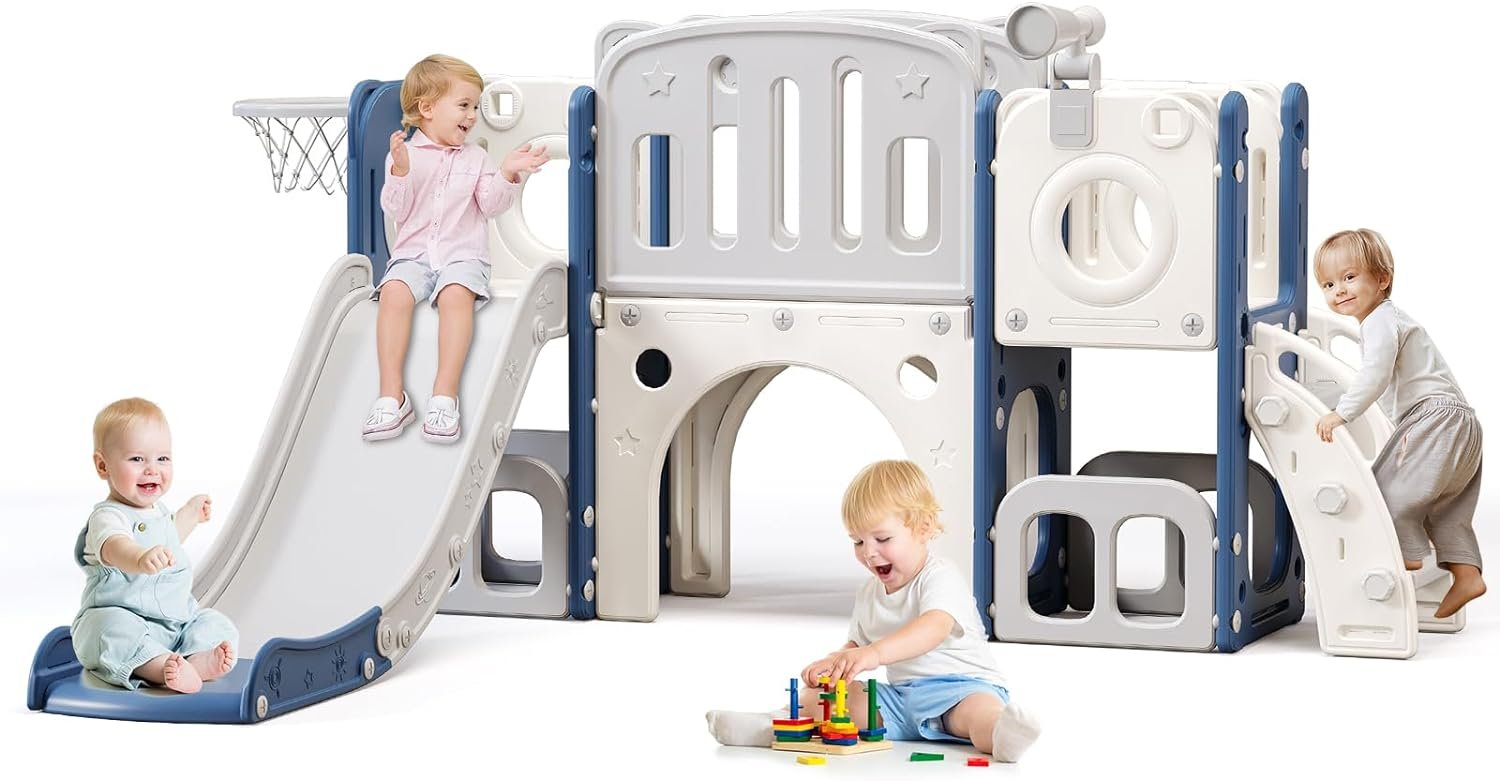Rainy days often bring a common challenge for parents—keeping energetic kids entertained indoors. The great outdoors becomes off-limits, and screen time seems like the only fallback. But here’s a better alternative: indoor climbing toys for rainy days. These innovative and engaging play structures don’t just save the day; they also promote physical activity, boost creativity, and turn a gloomy day into a fun adventure.
From toddlers to older kids, indoor climbing toys come in various shapes, sizes, and materials. Whether you’re living in a spacious home or a cozy apartment, there’s something for everyone. And the best part? Kids can burn energy, build strength, and develop coordination—all while staying dry and safe inside.
Let’s dive into why these toys are an absolute game-changer and explore the best options for your family.
Why Indoor Climbing Toys Are a Must-Have for Rainy Days
The Challenges of Keeping Kids Active Indoors
Rainy weather can quickly derail a parent’s game plan. Gone are the walks to the park, backyard playdates, or scooter rides around the block. Suddenly, you’re scrambling to fill the hours with something that doesn’t involve endless episodes of cartoons or iPad games. Sound familiar?
Indoor energy needs an outlet. Without it, kids get cranky, restless, and well… wild. They need movement, challenges, and fun. This is where indoor climbing toys come in. Think of them as your rainy day superhero—ready to save your sanity while giving your child a healthy way to play.
Not only do these toys provide entertainment, but they also encourage independence. Kids get to explore, climb, and create their own little adventures. Plus, climbing builds confidence—especially when they conquer a new height or master a tricky route.
The Physical and Mental Benefits of Climbing Toys
We all know that physical play is essential, but climbing adds a unique twist. It’s not just about burning energy—it’s about developing crucial life skills.
- Balance and coordination: As children learn to climb, they naturally enhance their motor skills and body awareness.
- Strength and endurance: Climbing helps build muscle strength in arms, legs, and core, all while being low-impact.
- Problem-solving skills: Navigating where to place their hands and feet sharpens their decision-making abilities.
- Confidence and risk assessment: Each successful climb reinforces their sense of achievement and teaches safe risk-taking.
More than that, climbing reduces screen time and encourages real-world interaction. Kids become immersed in tactile, sensory-rich play—something that digital toys just can’t replicate.
Types of Indoor Climbing Toys for Rainy Days
Choosing the right indoor climbing toy means understanding the variety available. Some are ideal for toddlers, others suit older children. Some are compact and foldable; others require a dedicated playroom. Let’s break down the most popular types to help you find your perfect match.
Indoor Jungle Gyms
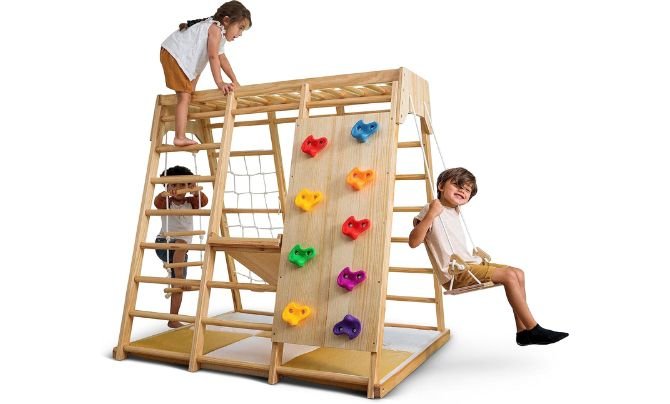
➡️ Check Latest Price on Amazon
Indoor jungle gyms are the all-in-one solution. Think monkey bars, ladders, slides, and even mini rock walls—all in a compact setup. These gyms provide multiple forms of play in one unit, keeping your child engaged for hours.
- Great for multi-child households
- Encourages active group play
- Usually made from wood or metal
- Can be freestanding or wall-mounted
They are often modular, meaning you can add accessories like rings or swings later. They’re excellent for long-term use and can grow with your child.
Climbing Domes and Triangles
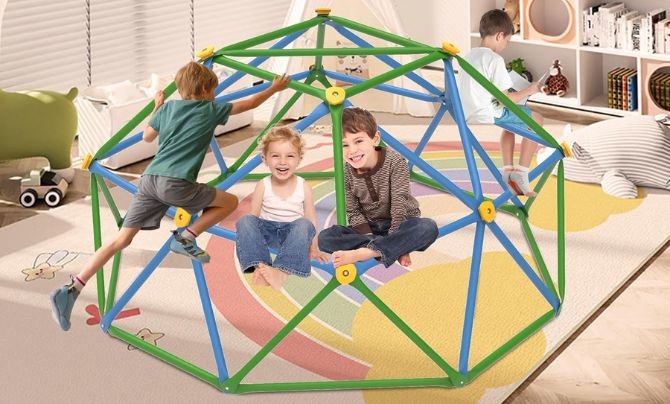
These are some of the most versatile indoor climbing toys. Climbing domes are often metal-based and encourage 360-degree movement. Pikler triangles, popular in Montessori setups, are made from wood and allow for controlled, open-ended climbing.
- Domes are better for older toddlers and preschoolers
- Triangles work great for younger toddlers
- Both can be combined with ramps or slides for added fun
Triangles, in particular, support child-led exploration, making them a favorite among educators and parents alike.
Soft Play Equipment
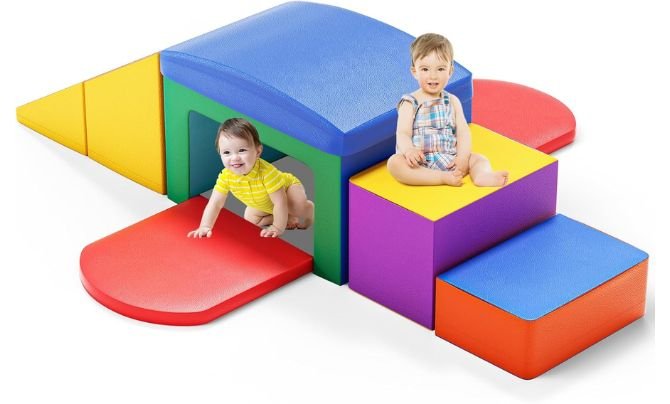
➡️ Check Latest Price on Amazon
If you have a younger toddler or a baby just starting to explore movement, soft play equipment is a safe and inviting option. These are foam-based climbing blocks or steps that are lightweight and easy to rearrange.
- Perfect for crawling, rolling, climbing, and jumping
- Extremely safe and forgiving for falls
- Easy to clean and move around
Soft play toys encourage imagination too. Today it’s a castle, tomorrow it’s a fort or spaceship. Kids love to create their own little play worlds with these.
Indoor Slides and Swings
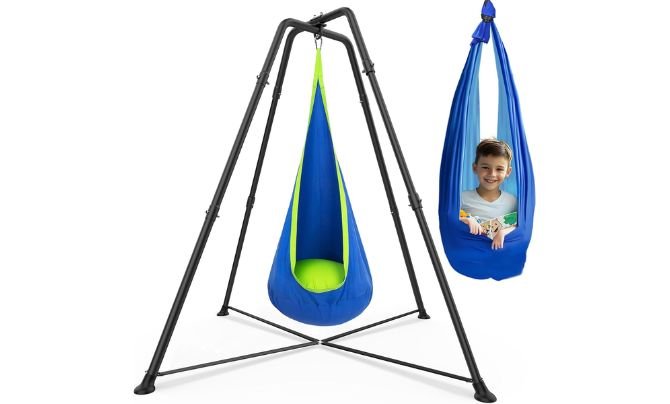
Yes, even slides and swings can live indoors! There are specially designed indoor models that are compact, safe, and surprisingly easy to set up.
- Slides are great add-ons to climbing frames or can be standalone
- Swings (like pod or sensory swings) can hang from door frames or ceiling mounts
- Ideal for sensory integration and vestibular stimulation
Adding movement-based toys like swings helps regulate sensory input, especially for kids with sensory processing needs.
✅ Related Articles
- DIY Playhouse Ideas for Budget-Friendly Parents
- The Truth About Swing and Slide Combo Playsets | Pros, Cons
- How to Install a Swing Set: Step-by-Step Guide
- 2026’s Best Swing Sets for Kids | Top 10 Picks Parents Love
Top Features to Look for in Indoor Climbing Toys
Before you hit “buy now,” it’s crucial to understand what makes a climbing toy both fun and safe. Not all products are created equal, and your child’s age, space, and activity level will influence the right choice.
Safety First: Materials and Construction
Safety should always be the top priority. Look for these must-haves:
- Rounded edges and non-toxic finishes
- Stable base and sturdy design
- Safety certifications (like ASTM or CPSC in the U.S.)
- No small detachable parts that could become choking hazards
For wooden toys, check for splinter-free surfaces. For metal toys, ensure rust-proof coatings. Never compromise on structural integrity.
Size and Space Considerations
Not every family has a dedicated playroom, and that’s okay. Measure your space before buying, and consider foldable or modular designs.
- Foldable triangles or slides for easy storage
- Wall-mounted gyms to save floor space
- Vertical setups that take advantage of ceiling height
It’s all about making the most of your space without overcrowding it.
Versatility and Multi-functionality
Toys that do more than one thing get more use—simple as that.
- Climbing + sliding + hiding in one setup
- Attachments like swings, ball pits, or tunnels
- Reconfigurable parts to keep playtime fresh
Multi-use toys grow with your child and justify the investment over time.
Age-Appropriate Designs
Different age groups need different features:
- 0–2 years: Soft, low-level climbing toys with lots of padding
- 2–4 years: Pikler triangles, short slides, climbing cubes
- 5+ years: Domes, indoor gyms, monkey bars
Always check manufacturer guidelines and err on the side of caution when your child is on the edge of an age range.
Best Indoor Climbing Toys for Toddlers
When shopping for toddlers, the focus should be on simplicity, safety, and sensory-friendly materials. The ideal toy should encourage movement without overwhelming them.
Compact Designs for Small Spaces
Living in an apartment or tight on room? Look for:
These are perfect for temporary setups that can be stored away when not in use. Some brands even offer climbing sets with built-in toy storage—talk about smart design!
Easy-to-Clean and Soft Surfaces
Spills and messes are inevitable with toddlers. Prioritize:
- Water-resistant foam and vinyl surfaces
- Machine-washable fabric covers
- Easily wipeable plastic parts
Materials matter. Soft foam with good density ensures comfort and safety without being too plush or unstable.
Best Indoor Climbing Toys for Older Kids
As children grow, so do their energy levels—and their need for more challenging activities. Indoor climbing toys for older kids must be strong, stimulating, and designed to hold their weight safely. These aren’t just toys anymore—they’re mini adventure zones for active kids.
Sturdier Builds and More Challenging Features
Older kids crave excitement and complexity. A basic climbing frame won’t cut it anymore. They want to swing, hang, balance, and scale new heights. That means:
- Larger climbing domes with higher weight capacities
- Wall-mounted climbing panels or bouldering walls
- Indoor ninja courses with ropes, rings, and ladders
These types of setups push physical boundaries and help build real strength, agility, and coordination. Look for equipment that challenges your child’s problem-solving too, like routes they can set and reset.
Durability is non-negotiable. You want solid metal frames, reinforced joints, and robust materials that won’t wear down quickly—even with daily use. Think of it as investing in a gym disguised as a toy.
Expandable or Modular Options
One of the coolest features for older kids is modularity. It keeps play interesting and gives them ownership over their space.
- Some jungle gyms can be expanded with extra accessories like climbing ropes, rock holds, or slides.
- Modular rock walls allow you to rearrange climbing grips and add difficulty.
- Even freestanding frames may come with optional monkey bars or rope ladders to add later.
Kids love variety. Giving them the ability to change their climbing toy keeps boredom at bay and adds an element of novelty every few weeks. Plus, they’ll feel more connected to the setup when they can help customize it.
If you’ve got the room and the budget, an expandable system can provide years of entertainment and growth opportunities.
DIY Indoor Climbing Toys for Rainy Days
Not all great climbing toys come with a hefty price tag or need to be store-bought. With a little creativity and a trip to the hardware store, you can build your own indoor climbing play area. It’s a fun project—and your kids will love being involved.
Affordable Options You Can Build at Home
Let’s face it, quality indoor climbing toys can be pricey. But if you’ve got some basic tools and a bit of DIY spirit, you can save money while creating something completely unique.
Here are a few budget-friendly ideas:
- Pikler Triangle DIY kits are widely available online with pre-cut wood and instructions.
- PVC pipe climbing frames are inexpensive, lightweight, and surprisingly sturdy.
- Rock climbing walls can be built using plywood, T-nuts, and climbing holds.
- Rope ladders or swinging rings can be hung from beams or secure mounts in the ceiling.
These projects range in complexity, but many can be completed in a weekend. Plus, you get full control over dimensions, color schemes, and added features like paint or decals.
It’s a chance to bond with your kids too—building something together makes the end result all the more special.
Repurposing Furniture into Climbing Zones
You don’t always need to build from scratch. Sometimes, the best indoor climbing toys for rainy days are already hiding in your home.
- Couch cushions can become a soft climbing hill or jumping platform.
- Bookshelves (secured properly) can double as a mini climbing wall.
- Under-table forts can be integrated with soft steps or tunnels.
- Old mattresses or foam pads can serve as fall zones or climbing props.
With a little imagination and some safety padding, you can turn ordinary furniture into an obstacle course. Just make sure everything is secure and supervised during playtime.
How to Set Up a Safe Indoor Climbing Space
Once you’ve chosen the perfect climbing toy, it’s time to think about placement and safety. A well-thought-out setup minimizes risks and maximizes fun.
Padding and Flooring Ideas
Falls happen, even with the best climbers. That’s why good flooring is essential.
- Foam play mats or interlocking EVA tiles offer cushioning and slip resistance.
- Gym-grade crash pads are ideal for climbing walls or domes.
- Carpet with thick underlay can work in a pinch but isn’t as impact-absorbing.
You’ll want to cover the entire play area, not just the area directly below the toy. Kids move in all directions—and sometimes unexpectedly!
Also consider wall padding if the toy is close to a wall. Thin foam panels or even large pillows can protect against bumps.
Room Layout Tips
Before installing any equipment, measure your space carefully. You’ll need enough room not just for the toy itself, but also for safe movement around it.
- Leave at least 3 feet of clearance on all sides.
- Avoid sharp corners or low-hanging items nearby.
- Choose a room with natural light to keep the mood cheerful.
Bonus tip: Put storage bins nearby for quick cleanup. Climbing play tends to get messy with added toys, costumes, or building blocks. Having storage close by keeps things organized without killing the vibe.
If you’re planning to mount anything to walls or ceilings, be 100% sure they can support the load. Always use heavy-duty anchors and double-check weight limits. Safety first, always.
👉 You Might Be Interested In
- 25+ Must-Have Accessories for Kids’ Playhouses That Children Will Love
- Premium Wooden Swing Sets | The Ultimate Backyard Upgrade in 2026
- 10 Best Heavy-Duty Swing Sets for Older Kids | Tested
- Small Backyard? Here Are 10 Must-Have Playsets for Kids
- Swing Set Safety Tips Every Parent Must Know | Ultimate Guide
- 10 Best Budget Swing Sets Under $500 That Parents Love
Encouraging Active Play During Rainy Days
Even the best climbing toy needs a little encouragement now and then. While some kids dive in naturally, others may need a gentle push to engage. Creating an inviting atmosphere and offering the right incentives can make all the difference.
Setting Playtime Routines
Establishing a daily routine around indoor play helps make it part of your child’s normal day—even when the weather is less than ideal.
- Set aside a specific time each day for climbing play.
- Use it as a reward after quiet time, schoolwork, or chores.
- Create a “Rainy Day Adventure” theme with fun names and goals.
Routine makes the activity predictable and something your child looks forward to. Over time, it becomes a natural way to release energy and get moving.
Integrating Learning into Climbing Activities
Play and learning go hand in hand. With a little creativity, indoor climbing toys can become tools for education as well as exercise.
- Number games: Place numbered stickers on holds or platforms and ask your child to touch them in order.
- Color challenges: Have your child only step on blue or red pieces to build pattern recognition.
- Imaginative play: Pretend the climbing dome is a mountain, spaceship, or jungle gym.
This fusion of learning and play promotes critical thinking, memory, and even language development—all while having a blast.
You can also join in the fun! When parents participate, kids get extra motivation and a sense of connection. It’s a win-win for the whole family.
Budget-Friendly Indoor Climbing Toys
You don’t have to spend a fortune to keep your kids active indoors. Plenty of budget-friendly climbing toys offer just as much fun as their high-end counterparts.
Where to Shop for Affordable Options
Here are a few budget-hunter favorites:
- IKEA: Great for simple structures and soft play items
- Facebook Marketplace or Craigslist: Find gently used climbing toys at a fraction of the price
- Walmart and Target: Budget indoor slides and jungle gyms
- Local parenting groups: Great for giveaways or trades
It’s all about knowing where to look. Shopping off-season or during sales events (like Black Friday or back-to-school) can also yield huge savings.
Tips for Finding Secondhand Deals
Buying secondhand can be a smart move, but you’ve got to be savvy about it.
- Inspect for damage before purchasing
- Ask about original manuals or setup instructions
- Check for recalls (especially on older equipment)
- Sanitize thoroughly before letting kids play
If a toy is missing a few pieces, don’t dismiss it right away—many manufacturers offer replacement parts online. With a little effort, a secondhand climbing toy can be as good as new for half the price.
Maintenance and Cleaning Tips for Indoor Climbing Equipment
Once you’ve set up your climbing toys, keeping them clean and well-maintained is essential—not just for longevity but for safety too. Kids touch everything, spill on everything, and sometimes even climb with sticky hands. So let’s make sure your investment stays in top shape.
Material-Specific Cleaning Guides
Different toys need different cleaning strategies depending on the material. Here’s how to handle the most common types:
- Wooden Toys: Use a damp cloth with mild soap. Avoid soaking or using harsh chemicals to prevent warping. Occasionally sand down rough edges and reapply child-safe sealant.
- Plastic Equipment: Wipe with disinfectant wipes or a mixture of vinegar and water. These are usually low-maintenance and mold-resistant.
- Metal Frames: Keep an eye out for rust, especially in humid environments. Wipe down with a dry cloth regularly and use a rust-preventive spray when necessary.
- Foam or Vinyl Soft Play Items: Use antibacterial spray or soapy water with a microfiber cloth. Make sure to dry thoroughly to avoid mold buildup.
Check for removable covers on cushions or pads—they’re often machine-washable, making cleaning even easier.
Routine Safety Checks
Just like a car needs maintenance, so does climbing equipment. A monthly inspection can prevent accidents and extend the toy’s lifespan.
Here’s what to look for:
- Loose screws or bolts: Tighten them immediately.
- Worn-out padding or covers: Replace as needed to maintain softness.
- Signs of splintering (wood) or rust (metal): Sand, repaint, or patch as required.
- Hanging accessories: Check ropes, clips, and carabiners for wear.
Encourage your kids to help with inspections—it gives them a sense of responsibility and helps them understand safe play habits. Make it a regular part of your rainy day routine.
Indoor Climbing Toys vs. Outdoor Playsets
You might be wondering—if I already have an outdoor playset, do I really need an indoor one? The answer depends on your child’s needs, climate, and available space. But let’s compare them side by side.
Pros and Cons of Indoor vs. Outdoor
| Feature | Indoor Climbing Toys | Outdoor Playsets |
|---|---|---|
| Weather Protection | ✔ Always usable | ✘ Weather dependent |
| Supervision | ✔ Easier indoors | ✘ Often far from sight |
| Safety | ✔ Softer flooring | ✘ Harder surfaces |
| Size | ✘ Usually smaller | ✔ Larger structures |
| Sensory Experience | ✘ Limited exposure | ✔ Natural stimuli |
| Maintenance | ✔ Easier indoors | ✘ Exposed to elements |
Indoor toys win for convenience, safety, and year-round use. Outdoor sets excel in providing larger-scale adventure and fresh air. Ideally, having both offers the best of both worlds.
When to Use Each Option
Think of them as complementary rather than competitive. During spring and summer, outdoor playsets can dominate. Come fall, winter, or rainy days, indoor climbing toys take center stage.
Also consider:
- Health reasons: Kids with allergies or asthma may benefit from the cleaner indoor air.
- Space constraints: No yard? Go for indoor climbing.
- Age and supervision needs: Younger kids often play better under indoor conditions where parents can be close.
In essence, indoor climbing toys aren’t just substitutes for outdoor fun—they’re stand-alone play solutions that meet kids where they are, rain or shine.
Parental Supervision and Safety Guidelines
No matter how “safe” a toy claims to be, supervision is still key. Especially with climbing equipment, active oversight can make the difference between fun and injury.
Establishing Ground Rules
Before letting your child go wild on a new climbing toy, set a few house rules:
- No pushing or shoving on the structure.
- One climber at a time for certain toys (like slides or triangles).
- No socks on slippery surfaces—barefoot is best for grip.
- No climbing while eating or drinking to prevent choking.
- Always ask an adult before rearranging parts or accessories.
Rules help create boundaries. And when those rules are enforced consistently, kids learn to take ownership of their playtime in a safe, structured way.
What to Watch Out For
While your kids play, keep an eye on:
- Slippery surfaces from spilled drinks or sweaty feet.
- Tiredness or frustration—signs it’s time for a break.
- Roughhousing that could escalate into unsafe behavior.
- Equipment misuse, like hanging from unstable parts or standing on the top rail.
Even with older kids, periodic check-ins are helpful. They may act like they’ve “got this,” but accidents can happen quickly.
Also, have a first aid kit nearby, just in case. It’s better to be prepared than scrambling when someone takes a tumble.
How Indoor Climbing Toys Improve Developmental Skills
You already know indoor climbing toys are fun and energy-burning. But did you know they’re also developmental powerhouses? Every time your child climbs, crawls, or swings, they’re building more than muscles.
Motor Skills and Coordination
Climbing toys help build both gross and fine motor skills. Here’s how:
- Gross motor: Crawling up a ramp, climbing a ladder, or sliding down helps improve strength, balance, and body control.
- Fine motor: Gripping handholds, positioning feet, or adjusting to new surfaces improves finger strength and dexterity.
This development is crucial during early childhood when the brain and body are still learning to work together efficiently.
Climbing also enhances proprioception—the ability to sense body position in space. Kids learn how to move without bumping into things or falling off balance. It’s like training their internal GPS.
Cognitive and Social Benefits
Beyond physical gains, climbing also boosts brain power and social skills.
- Problem-solving: Figuring out how to reach the top or use a ramp creatively strengthens logical thinking.
- Risk assessment: Kids learn what they can and can’t do safely, building confidence and caution.
- Imagination: Climbing toys become pirate ships, castles, or obstacle courses in your child’s world.
- Social interaction: With siblings or friends, they learn turn-taking, cooperation, and even leadership.
For children with special needs or sensory sensitivities, climbing toys can also be therapeutic. They provide controlled sensory input and can help regulate mood and focus.
In short, climbing isn’t just play—it’s learning in disguise.
Frequently Asked Questions About Indoor Climbing Toys
Q1: Are indoor climbing toys safe for toddlers?
Yes, many climbing toys are specifically designed for toddlers with low heights, soft materials, and rounded edges. Always supervise and follow age guidelines.
Q2: How much space do I need for an indoor climbing toy?
You can find toys for all space types—from small foldable triangles for apartments to large jungle gyms for playrooms. Measure your available area and leave room for safe movement.
Q3: What’s the best climbing toy for a 3-year-old?
Pikler triangles, soft block sets, or toddler-sized slides with climbing frames are great. Look for sturdy, stable, and age-rated options.
Q4: Can climbing toys help with sensory processing?
Absolutely. They provide vestibular input (movement-based sensory input) and proprioceptive feedback, helping kids with sensory processing needs regulate their bodies.
Q5: Where can I find budget-friendly climbing toys?
Check big-box stores like IKEA, Walmart, or Target. Also, look at secondhand platforms like Facebook Marketplace or parenting groups for deals.
Conclusion: Make Rainy Days Active and Fun
Rainy days don’t have to mean restless kids and frazzled parents. With the right indoor climbing toys for rainy days, you can transform your home into a fun, safe, and active play space. From toddlers to school-age adventurers, there’s something for everyone.
Not only do these toys provide endless entertainment, but they also support physical, cognitive, and social development. Whether you choose a store-bought jungle gym, a DIY climbing wall, or a soft foam setup, the key is to create a space where your child can explore, move, and grow—even when the sun’s not shining.
So go ahead—bring the playground indoors and let the adventure begin!



